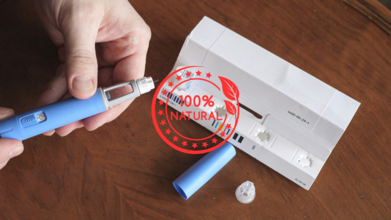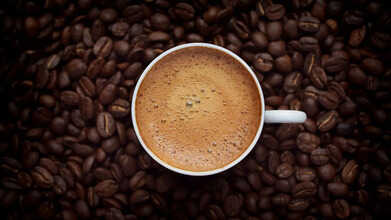- Health Conditions A-Z
- Health & Wellness
- Nutrition
- Fitness
- Health News
- Ayurveda
- Videos
- Medicine A-Z
- Parenting
This Naturally Occurring Molecule May Have Ozempic-like Benefits Without The Side Effects

Credits: Canva
What if we tell you that a naturally occurring molecule can do wonders like Ozempic, but without the side effects. Hard to believe, isn't it? However, Stanford Medicine researchers have found a molecule that acts similar to semaglutide, by suppressing appetite and reducing body weight. The trials on animals have also shown that it worked without some of the drug's side effects, including nausea, constipation and significant loss of muscle mass.
The paper was published on March 5 in Nature, and led by Laetitia Coassolo, PhD, Kartin Svensson, assistant professor of pathology.
What Is This Naturally Occurring Molecule?
This newly discovered molecule is BRP. This acts, though, in a separate pathway, but has similar metabolic effects. It can activate different neurons in the brain and offer a more targeted approach to body weight reduction.
Stanford Medicine's release quoted Svensson, PhD, who explained, "the receptors targeted by semaglutide are found in the brain but also in the gut, pancreas and other tissues. That’s why Ozempic has widespread effects including slowing the movement of food through the digestive tract and lowering blood sugar levels. In contrast, BRP appears to act specifically in the hypothalamus, which controls appetite and metabolism.”
Svensson has also co-founded a company to launch clinical trials of the molecule in humans in the near future.
How Was The Study Conducted?
This study would not have been possible without the help of AI, notes the release. Researchers used AI to sift through dozens of proteins in a group called prohormones.
Prohormones are molecules that do not do anything on their own at first. They become active only after being cut into smaller pieces, called peptides, by other proteins. Some of these peptides then act as hormones, controlling important functions in the body, such as energy use in the brain and other organs.
Each prohormone can be cut in different ways, producing many possible peptides. Among these, only a few actually work as hormones, while most are just byproducts of protein breakdown. Traditional lab methods make it hard to find the useful peptides in this mix.
The researchers focused on an enzyme called prohormone convertase 1/3, which cuts prohormones at specific points in the amino acid chain. This enzyme has been linked to obesity in humans. One of the peptides it produces is GLP-1, which helps control appetite and blood sugar levels.
The drug semaglutide works by mimicking GLP-1. The team wanted to see if there were other peptides from this enzyme that also play a role in energy metabolism.
To do this, they created a computer program called Peptide Predictor. Instead of manually sorting through proteins, the program scanned all 20,000 human protein-coding genes to find likely cutting sites for prohormone convertase 1/3. They focused only on proteins that are secreted outside the cell, a key feature of hormones, and that had at least four cutting sites. This narrowed the list to 373 prohormones.
The program predicted that these could produce 2,683 unique peptides. The team then looked at those most likely to act in the brain and tested 100 of them, including GLP-1, on lab-grown nerve cells.
GLP-1 increased cell activity about three times compared to normal cells, as expected. But one small peptide, just 12 amino acids long, increased activity tenfold. They named it BRP, based on the name of its parent protein BRINP2.
What Did The Result Reveal?
Tests on lean mice and minipigs showed promising results. An injection of BRP before feeding reduced food intake by up to 50% over the next hour. In obese mice, daily injections for two weeks led to an average weight loss of 3 grams, mostly fat, while untreated mice gained about 3 grams. The treated mice also had better blood sugar control.
Importantly, BRP did not change the animals’ movement, water intake, anxiety levels, or digestion. It also works through different brain and body pathways than GLP-1 or semaglutide, which could make it useful for people who do not respond well to those drugs.
What's Next?
Researchers now want to find the exact cell receptors BRP binds to and figure out how to make its effects last longer in the body. If it proves safe and effective in humans, BRP could offer a new option for treating obesity.
The study was a collaboration between scientists at the University of California, Berkeley, the University of Minnesota, and the University of British Columbia.
Orange Juice For Heart? A New Study Reveals Why It Is Great For Cardiovascular Health

Credits: iStock
If you like orange juice and drink it daily for your breakfast, you are good to go. But, if you are someone who does not drink orange juice, you may want to reconsider your food habits. Scientists found that that orange juice could actually extend your healthy life and benefit your cardiovascular health.
The study published in Wiley Online Library revealed that orange juice consumption could influence the activity of thousands of genes inside our immune cell. Many of these genes also control blood pressure, calm inflammation and manage the way the body processes sugar. All these functions play an important role for long-term heart health.
How Was The Study Conducted?
The study followed adults who drank 500ml of pure pasteurized orange juice everyday for two months. After a period of two months, many genes that leads to inflammation and higher blood pressure had become less active.
What Were These Genes? These included NAMPT, IL6, IL1B, and NLRP3. These genes switch on when the body is under stress. There is another gene called SGK1 that impacts kidneys ability to hold onto sodium or salt, which also became less active. These changes have also matched a previous findings that showed daily orange juice consumption could also reduce blood pressure. Orange juice contains hesperidin, a flavonoid that could help lower blood pressure. There are antioxidants too that are great for overall heart health.
What About The Blood Sugar Levels?
The trials have shown that orange juice does not simple raise blood sugar levels, instead, it triggers small shifts in the body's regulatory system that could reduce inflammation and also help blood vessels relax.
However, what is important to note is that hesperidin that influences the genes have varied response based on a person's body size. So, people who weigh more could show greater changes in gene, which also involves fat metabolism, while leaner people could show stronger effects on inflammation.
Orange And Heart Health
A systematic review from 2021, published in the journal Phytotherapy Research that involved 639 participants from 15 different studies also found that regular orange juice consumption lowered insulin resistance and blood cholesterol levels. Insulin resistance is what leads to diabetes, as it is the precursor for pre-diabetes, and high cholesterol is linked with heart diseases.
Another 2022 study published in journal Food & Function showed that overweight and obese adults noticed small reduction in systolic blood pressure and increase in high-density lipoprotein or HDL, which is also known as the 'good cholesterol'. This result was achieved only after several weeks of orange juice consumption. While these changes were modest, the improvements could make a greater difference, if the same food habits are maintained for years.
More answers come from looking at metabolites, the tiny molecules our bodies make while breaking down food. A recent review found that orange juice can influence several key pathways, including how we use energy, how our cells communicate, and how the body manages inflammation. It may even shape the gut microbiome, which experts now know plays a big role in heart health.
Furthermore, a 2023 study published in the journal Frontiers In Microbiology noted that people who drank blood orange juice daily for a month saw an increase in gut bacteria that produce short-chain fatty acids, compounds known to support healthy blood pressure and lower inflammation. These volunteers also showed better blood sugar control and reduced levels of inflammatory markers, hinting that the benefits of orange juice may go far beyond its refreshing taste.
Punjab Worst Hit By High Uranium Levels In India’s Groundwater; Raise Health Concerns

Credits: iStock
The latest Annual Ground Water Quality Report 2025 by the Central Ground Water Board (CGWB) has delivered a worrying revelation: Punjab now records the highest intensity of uranium contamination ever reported in India, with 62.5% of groundwater samples exceeding the safe limit post-monsoon. This is followed by Haryana, Delhi, Karnataka and Uttar Pradesh, indicating a dangerous pattern across north and north-central India.
While nitrate and fluoride remain more widespread contaminants, uranium’s increasing presence raises an urgent public health concern because even low-dose, long-term exposure can quietly harm vital organs.
Where Is Uranium Contamination Rising?
The CGWB tested 3,754 groundwater samples across India in pre- and post-monsoon seasons. The findings show a clear upward trend:
Nationally, uranium exceedance rose from 6.71% (pre-monsoon) to 7.91% (post-monsoon).
Punjab recorded the highest contamination:
- 53.04% pre-monsoon
- 62.50% post-monsoon
Haryana followed with 15–23.75% of samples above limits.
- Delhi: 13–15.66%
- Karnataka: 6–8%
- Uttar Pradesh: 5–6%
The report highlights northwestern India: Punjab, Haryana, Delhi, and parts of Rajasthan and Uttar Pradesh — as the main hotspot, likely due to geogenic factors, aquifer depletion, and intense groundwater extraction. Meanwhile, eastern and southern states reported minimal contamination.
Why Uranium in Water Is Dangerous
According to the 2025 study “Uranium’s hazardous effects on humans and recent developments in treatment,” the real threat from uranium lies in its chemical toxicity, not its radioactivity.
Kidney Damage: The Most Significant Risk
Uranium behaves like a heavy metal that gets absorbed and stored in the kidneys, impairing their ability to filter waste.
This can lead to:
- Proteinuria (excess protein in urine)
- Reduced kidney function
- Long-term kidney diseases
Even low-dose, chronic exposure through drinking water can gradually weaken renal functioning.
Respiratory Harm and Lung Cancer Risk
People who inhale uranium particles — especially workers in mining or processing — face:
- Chronic respiratory irritation
- Persistent coughing
- Higher risk of lung cancer, particularly due to radon gas produced as uranium decays
Gastrointestinal Entry and Toxic Build-Up
Recent findings note that the gastrointestinal system is the main route of uranium entry. Once consumed through contaminated water, uranium moves from the stomach and intestines into soft tissues and organs.
Bone Accumulation and Cancer Risk
Because uranium is a chemical analog of calcium, it can get deposited into bones. Over time, this raises the risk of bone cancer and may interfere with normal bone cell functioning.
Possible Reproductive and Developmental Effects
Animal studies suggest:
- Potential risks of congenital disabilities
- Effects on reproductive organs
- But direct evidence in humans remains incomplete, calling for more research.
Neurological and Immune Effects Being Explored
Some studies hint at:
- Behavioral changes
- Cognitive deficits
- Unclear impacts on the immune system
These areas remain under-studied but concerning.
Why India Must Worry Now
The CGWB report warns that while most groundwater in India remains safe, the pockets of rising uranium contamination require immediate monitoring and mitigation. With millions relying on groundwater for daily consumption, even a small rise in toxic metals can translate into widespread health damage over time.
Long-term exposure rarely shows immediate symptoms, which makes the threat quiet but deeply harmful.
Daily Coffee Consumption May Slow Biological Aging by Five Years, Experts Suggest

Credits: Canva
A new study suggests that drinking coffee could help certain individuals slow their biological ageing. Researchers found that consuming up to four cups a day may give some people a biological advantage, effectively making their cells appear five years younger than those who abstain. The study, published in BMJ Mental Health, focused on people with severe mental illnesses, including schizophrenia, bipolar disorder, and psychosis.
How Coffee Might Affect Ageing
The scientists linked this effect to coffee’s high antioxidant content, which appears to protect and lengthen telomeres—the protective caps at the ends of chromosomes. Telomeres function like the plastic tips on shoelaces, preventing chromosomes from fraying. Normally, telomeres shorten naturally as we age, but in people with major psychiatric conditions, this process is often accelerated, contributing to premature cellular ageing.
According to News Medical, coffee’s antioxidants can reduce oxidative stress, a factor that speeds up telomere shortening and biological ageing. By consuming the optimal amount, individuals may slow this process, potentially gaining the equivalent of five years of cellular youth.
The Study: Coffee, Mental Health, and Telomeres
The study observed 436 adults, including 259 participants with schizophrenia and the remainder with affective disorders like bipolar disorder or major depressive disorder with psychotic features. Researchers analyzed participants’ coffee consumption and its impact on telomere length.
Results showed that drinking up to four cups daily was associated with longer telomeres. However, consuming more than five cups each day did not provide additional benefits; in fact, heavy coffee drinkers were biologically older compared to those consuming one or two cups. This highlights the importance of moderation, as excessive caffeine intake may lead to cellular stress and telomere shortening.
The study authors emphasized that while this research cannot definitively prove causation—because it was observational—coffee’s established health benefits make it a plausible contributor to preserving cellular health. As they noted: “Telomeres are highly sensitive to both oxidative stress and inflammation, further highlighting how coffee intake could help maintain cellular integrity in a population predisposed to accelerated ageing.”
Guidelines and Considerations
Global health authorities generally recommend limiting caffeine intake to around 400 mg per day, roughly equivalent to four cups of coffee. Staying within this range seems to provide the protective effects without overloading the body.
The researchers also acknowledged some limitations in the study. They did not track other sources of caffeine participants may have consumed, nor did they account for the type of coffee or the time of day it was consumed, factors that could influence outcomes.
Overall, the study reinforces the idea that moderate coffee consumption can be a simple lifestyle choice with potential long-term benefits for mental health populations and, possibly, the general population as well.
© 2024 Bennett, Coleman & Company Limited

